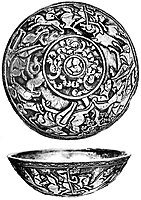
The Hephthalites, sometimes called the White Huns, were a people who lived in Central Asia during the 5th to 8th centuries CE. They formed an empire, the Imperial Hephthalites, and were militarily important from 450 CE, when they defeated the Kidarites, to 560 CE, when combined forces from the First Turkic Khaganate and the Sasanian Empire defeated them. After 560 CE, they established "principalities" in the area of Tokharistan, under the suzerainty of the Western Turks and of the Sasanian Empire, before the Tokhara Yabghus took over in 625.

Xionites, Chionites, or Chionitae were a nomadic people in the Central Asian regions of Transoxiana and Bactria.

The Kidarites, or Kidara Huns, were a dynasty that ruled Bactria and adjoining parts of Central Asia and South Asia in the 4th and 5th centuries. The Kidarites belonged to a complex of peoples known collectively in India as the Huna, and in Europe as the Chionites, and may even be considered as identical to the Chionites. The 5th century Byzantine historian Priscus called them Kidarite Huns, or "Huns who are Kidarites". The Huna/Xionite tribes are often linked, albeit controversially, to the Huns who invaded Eastern Europe during a similar period. They are entirely different from the Hephthalites, who replaced them about a century later.
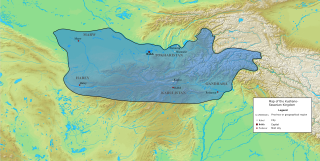
Kushano-Sasanian Kingdom is a historiographic term used by modern scholars to refer to a branch of the Sasanian Persians who established their rule in Bactria during the 3rd and 4th centuries CE at the expense of the declining Kushans. They captured the provinces of Sogdiana, Bactria and Gandhara from the Kushans in 225 CE. The Sasanians established governors for the Sasanian Empire, who minted their own coinage and took the title of Kushanshas, i.e. "Kings of the Kushans". They are sometimes considered as forming a "sub-kingdom" inside the Sasanian Empire. This administration continued until 360-370 CE, when the Kushano-Sasanians lost much of its domains to the invading Kidarite Huns, whilst the rest was incorporated into the imperial Sasanian Empire. Later, the Kidarites were in turn displaced by the Hephthalites. The Sasanians were able to re-establish some authority after they destroyed the Hephthalites with the help of the Turks in 565, but their rule collapsed under Arab attacks in the mid 7th century.
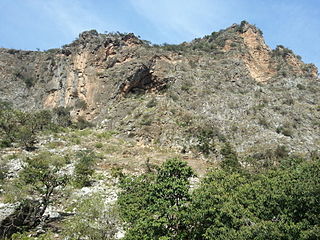
The Kashmir Smast caves, also called Kashmir Smats, are a series of natural limestone caves, artificially expanded from the Kushan to the Shahi periods, situated in the Babuzai Sakrah mountains in the Katlang Valley Mardan in Northern Pakistan. According to recent scholarship based on a rare series of bronze coins and artifacts found in the region, the caves and their adjacent valley probably comprised a sovereign kingdom in Gandhara which maintained at least partial independence for almost 500 years, from c. 4th century AD to the 9th century AD. For most of its history, it was ruled by White Hun governors or princes.

Khingila I was the founding king of the Hunnic Alkhan dynasty. He was a contemporary of Khushnavaz.
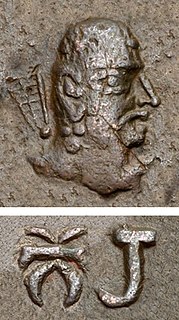
Toramana also called Toramana Shahi Jauvla was a king of the Alchon Huns who ruled in northern India in the late 5th and the early 6th century CE. Toramana consolidated the Hephthalite power in Punjab, and conquered northern and central India including Eran in Madhya Pradesh. Toramana used the title "Great King of Kings", equivalent to "Emperor", in his inscriptions, such as the Eran boar inscription.
Hunas or Huna was the name given by the ancient Indians to a group of Central Asian tribes who, via the Khyber Pass, entered the Indian subcontinent at the end of the 5th or early 6th century. The Huna Kingdom occupied areas as far south as Eran and Kausambi, greatly weakening the Gupta Empire. The Hunas were ultimately defeated by a coalition of Indian princes that included an Indian king Yasodharman and the Gupta emperor, Narasimhagupta. They defeated a Huna army and their ruler Mihirakula in 528 CE and drove them out of India. The Guptas are thought to have played only a minor role in this campaign.

Central Asian art is visual art created in Central Asia, in areas corresponding to modern Kyrgyzstan, Kazakhstan, Uzbekistan, Turkmenistan, Azerbaijan, Tajikistan, Afghanistan, Pakistan, and parts of modern Mongolia, China and Russia. The art of ancient and medieval Central Asia reflects the rich history of this vast area, home to a huge variety of peoples, religions and ways of life. The artistic remains of the region show a remarkable combinations of influences that exemplify the multicultural nature of Central Asian society. The Silk Road transmission of art, Scythian art, Greco-Buddhist art, Serindian art and more recently Persianate culture, are all part of this complicated history.
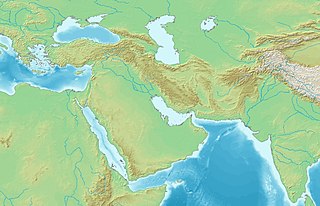
The Nezak Huns, also Nezak Shahs, formed a major principality in the south of the Hindu Kush region, active from circa 484 to 665 CE. Despite being traditionally identified as the last of the Hunnic states, their ethnicity remains disputed and speculative. The Nezaks ruled for about two centuries, spanning multiple generations. Notwithstanding an obscure history, they left behind significant coinage — with a characteristic water-buffalo-head crown — documenting their polity's prosperity.

The Alchon Huns, also known as the Alchono, Alxon, Alkhon, Alkhan, Alakhana and Walxon, were a nomadic people who established states in Central Asia and South Asia during the 4th and 6th centuries CE. They were first mentioned as being located in Paropamisus, and later expanded south-east, into the Punjab and central India, as far as Eran and Kausambi. The Alchon invasion of the Indian subcontinent eradicated the Kidarite Huns who had preceded them by about a century, and contributed to the fall of the Gupta Empire, in a sense bringing an end to Classical India.

Kidara I fl. 350-390 CE) was the first major ruler of the Kidarite Kingdom, which replaced the Indo-Sasanians in northwestern India, in the areas of Kushanshahr, Gandhara, Kashmir and Punjab.

Mehama, ruled c.461-493, was a king of Alchon Huns dynasty. He is little known, but the Talagan copper scroll mentions him as an active ruler making a donation to a Buddhist stupa in 492/93. At that time, it is considered that the Alchon Huns were firmly in charge of the Buddhist region around Taxila, but had not yet started to conquer the Indian mainland.

The term Iranian Huns is sometimes used for a group of different tribes that lived in Afghanistan and neighboring areas between the fourth and seventh centuries and expanded into northwest India. They are roughly equivalent to the Hunas. They also threatened the northeast borders of Sasanian Persia and forced the Shahs to lead many ill-documented campaigns against them.
The State Museum of Culture History of Uzbekistan is a museum of history and culture in Samarkand.

The Seal of Khingila is an historical seal from the region of Bactria, on southern Central Asia. The seal was published recently by Pierfrancesco Callieri and Nicholas Sims-Williams. It is now in the private collection of Mr. A. Saeedi (London). Kurbanov considers it as a significant Hephthalite seal. It has also been considered as intermediate between the Kidarites and the Hephthalites.

Tobazini, Gobazini or Goboziko was a ruler of southern Central Asia. He is only known from his coinage, found in Bactria and Northern Afghanistan. The legends on his coins are in Bactrian, but they are often difficult to read: a typical legend reads t/gobazini/o šauo "King Tobazini". Tobazini is often considered one of the last rulers of the Kidarites, circa 450 CE.

Toramana of Kashmir, was a ruler of Kashmir in the 6-7th century CE. This ruler has often been called "Toramana II" in numismatic studies, but this name now tends to be used for an earlier Alchon Hun ruler of Kabulistan: Toramana II.

Khingala, also transliterated Khinkhil, Khinjil or Khinjal, was a ruler of the Turk Shahis. He is only known in name from the accounts of the Muslim historian Ya'qubi and from an epigraphical source, the Gardez Ganesha. The identification of his coinage remains conjectural.
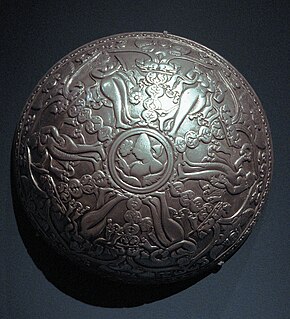
The Chilek silver bowl is a silver bowl found in the area of Samarkand, and considered as the "best known specimen of Hephthalite art". More specifically, the bowl seems to belong to the Alchon Huns, south of the Hindu-Kush, during the last third of the 5th century CE. The Alchons have long been considered as a part or a sub-division of the Hephthalites, or as their eastern branch, but now tend to be considered as a separate entity.






